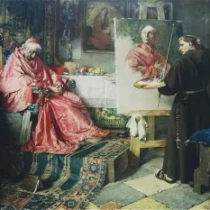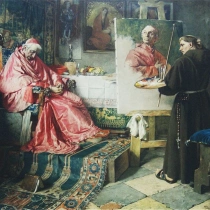 1848 - 1917
academic classicism, realism
1848 - 1917
academic classicism, realism
Description Toby Edward Rosenthal
Toby Edward Rosenthal, born in 1848 in New Haven, Connecticut, emerged as a distinguished American painter in the late 19th and early 20th centuries. His artistic journey unfolded against the backdrop of a rapidly changing America, capturing both the spirit of the time and the nuances of human emotion.
Rosenthal's early artistic talents were evident, and he began his formal training under landscape painter James M. Hart. However, his interest soon shifted to portraiture, leading him to study at the National Academy of Design in New York and later in Munich under the guidance of German artist Karl von Piloty.
The Munich Academy played a pivotal role in shaping Rosenthal's artistic style. Immersed in the academic traditions of Europe, he honed his skills in historical genre painting and portraiture. His time in Munich not only refined his technique but also exposed him to the vibrant art scene of the period.
Returning to the United States, Rosenthal established himself as a portraitist of repute. His portraits, characterized by a keen attention to detail and a nuanced understanding of his subjects, earned him acclaim and attracted a distinguished clientele.
Rosenthal's versatility extended beyond portraiture. His historical genre paintings, often depicting scenes from American history, captured the imagination of viewers. One notable work, "The Signing of the Constitution of the United States," showcased his ability to bring historical events to life with a sense of drama and authenticity.
Despite his success, Rosenthal faced the challenges of a shifting art world. The advent of Impressionism and other avant-garde movements posed new questions for artists. However, he remained committed to his academic approach, preserving a sense of continuity with the classical traditions he had absorbed in Munich.
Rosenthal's legacy endures in the rich tapestry of American portraiture and historical genre painting. His ability to capture the essence of his subjects, whether in intimate portraits or grand historical scenes, reflects a deep empathy and understanding of the human experience.
Toby Edward Rosenthal passed away in 1917, leaving behind a body of work that stands as a testament to the enduring power of representational art. In an era marked by artistic upheavals, his dedication to classical ideals and his contribution to the American art scene remain integral to understanding the complexities of artistic evolution in the late 19th and early 20th centuries.

No Comments Yet...